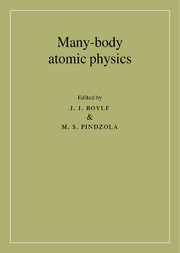Book contents
- Front Matter
- Contents
- Foreword
- Contributors
- Preface
- Acknowledgements
- Part 1 ATOMIC STRUCTURE
- Part 2 PHOTOIONIZATION OF ATOMS
- Part 3 ATOMIC SCATTERING: A. General Considerations
- Part 3 ATOMIC SCATTERING: B. Low-order applications
- Part 3 ATOMIC SCATTERING: C. All-order applications
- 13 R-matrix theory: some recent applications
- 14 Electron scattering from atomic targets: application of Dirac R-matrix theory
- 15 Electron-ion collisions using close-coupling and distorted-wave theory
- Appendix: Units and notation
- References
- Index
15 - Electron-ion collisions using close-coupling and distorted-wave theory
Published online by Cambridge University Press: 22 September 2009
- Front Matter
- Contents
- Foreword
- Contributors
- Preface
- Acknowledgements
- Part 1 ATOMIC STRUCTURE
- Part 2 PHOTOIONIZATION OF ATOMS
- Part 3 ATOMIC SCATTERING: A. General Considerations
- Part 3 ATOMIC SCATTERING: B. Low-order applications
- Part 3 ATOMIC SCATTERING: C. All-order applications
- 13 R-matrix theory: some recent applications
- 14 Electron scattering from atomic targets: application of Dirac R-matrix theory
- 15 Electron-ion collisions using close-coupling and distorted-wave theory
- Appendix: Units and notation
- References
- Index
Summary
Introduction
In this chapter, we consider various theoretical methods for the calculation of electron-impact excitation and ionization in positively charged ions. First, we compare the distorted-wave and close-coupling approximations for the calculation of the non-resonant contributions to electron-impact excitation. The close-coupling method takes into account coupling effects to all orders of perturbation theory for those states included in the close-coupling expansion, while the distorted-wave method treats coupling effects by first-order perturbation theory. By comparing calculations using these two approximations along an isoelectronic sequence, we study continuum coupling as a function of ionization stage.
In many cases, excitation cross sections are dominated by strong resonance features. These occur when an electron in the continuum of an N-electron ion coincides in energy with a compound doubly-excited state of the (N + 1)–electron ion. The continuum electron can be captured into the compound state, and if this state then undergoes autoionization to an excited state of the N-electron ion, we have a resonance in the excitation cross section. Such resonances are treated in a natural way within the close-coupling method. However, using perturbation theory, it is also possible to include them within a distorted-wave formalism. We focus on the independent-processes approximation, in which interference between the individual resonances and between the resonances and the non-resonant background is ignored. In order to study the validity of this approximation, we consider transitions for which the resonant contributions are significant and compare close-coupling calculations with independent processes calculations along an isoelectronic sequence.
- Type
- Chapter
- Information
- Many-Body Atomic Physics , pp. 349 - 370Publisher: Cambridge University PressPrint publication year: 1998

